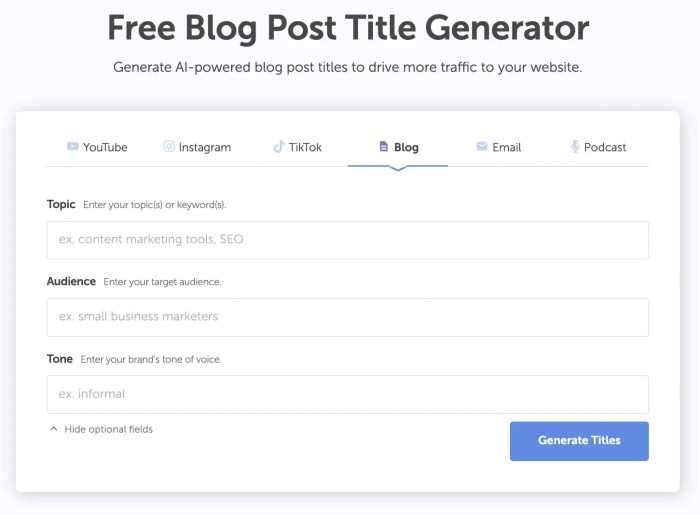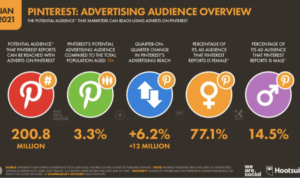Creating Engaging Blog Titles dives into the world of captivating headlines, showcasing the power of words to attract readers and boost . Get ready to explore the secrets behind crafting irresistible titles that leave a lasting impact.
From understanding the importance of attention-grabbing titles to mastering the art of testing and analyzing their effectiveness, this guide has you covered every step of the way.
Importance of Engaging Blog Titles

In the vast world of the internet, where attention spans are shorter than a TikTok video, engaging blog titles are like the cool kids in the cafeteria – they attract all the eyeballs. A killer title can make the difference between your blog post being a viral sensation or just another forgotten webpage in the vast expanse of cyberspace.
Examples of Successful Blog Titles
- “10 Ways to Level Up Your Instagram Game” – This title not only promises valuable tips but also creates intrigue by suggesting a potential improvement in social media presence.
- “The Ultimate Guide to Travel Hacks: How to See the World on a Budget” – By offering a solution to a common desire (traveling on a budget), this title entices readers seeking practical advice.
- “Unleash Your Inner Chef: Mouthwatering Recipes to Impress Your Dinner Guests” – This title appeals to both aspiring cooks and social hosts, promising delicious recipes and the chance to shine in the kitchen.
Impact of Captivating Titles on Click-Through Rates and , Creating Engaging Blog Titles
When your blog title is as enticing as the smell of fresh pizza in the cafeteria, it’s bound to attract more clicks. A captivating title not only grabs the reader’s attention but also boosts click-through rates, leading to increased traffic on your website. Moreover, search engines love a good title too! A well-crafted blog title can improve your ranking, making your content more discoverable to those seeking information on the topics you cover.
Elements of Engaging Blog Titles
Creating an engaging blog title is crucial in attracting readers and generating interest in your content. There are several key components that can make a blog title stand out and compel people to click and read further.
Power Words
Using power words in your blog title can evoke strong emotions and curiosity in readers. Words like “ultimate,” “amazing,” “essential,” or “unbelievable” can add a sense of urgency and importance to your title, making it more compelling.
Numbers
Incorporating numbers into your blog title can make it more specific and actionable. For example, “5 Tips for Healthy Eating” or “10 Ways to Improve Your Productivity” provide a clear idea of what readers can expect from the content, making it more enticing.
Questions
Asking a question in your blog title can pique readers’ curiosity and encourage them to click for answers. Questions like “Are You Making These Common Mistakes?” or “How Can You Achieve Financial Freedom?” can engage readers and prompt them to delve deeper into your content.
Emotions
Appealing to readers’ emotions in your blog title can create a connection and resonate with them on a personal level. Using emotional words like “heartwarming,” “inspiring,” or “heartbreaking” can draw readers in and make them more likely to engage with your content.
By incorporating power words, numbers, questions, and emotions into your blog titles, you can create a sense of curiosity and urgency that compels readers to click and explore your content further.
Tips for Crafting Engaging Blog Titles
Creating catchy headlines is essential to grab the attention of your target audience and entice them to click on your blog post. Here are some tips to help you craft engaging blog titles that resonate with your readers:
Importance of Relevance and Accuracy
It is crucial to ensure that your blog titles are relevant to the content of your post and accurately reflect what readers can expect to find. Misleading or clickbait titles may initially attract clicks but can ultimately lead to dissatisfaction and loss of credibility.
Use of Humor, Controversy, or Intrigue
Adding humor, controversy, or intrigue to your blog titles can pique the curiosity of your audience and make them more likely to click and read further. Just be sure that these elements are aligned with your brand voice and the overall tone of your content.
Best Practices for Testing Blog Titles: Creating Engaging Blog Titles

Testing blog titles is crucial to ensure optimal engagement with your audience. By conducting A/B testing, you can analyze the performance of different titles and determine which ones are most effective in capturing readers’ attention.
Importance of A/B Testing
A/B testing involves creating two versions of a blog title and presenting them to different segments of your audience. By measuring metrics such as click-through rates, time spent on page, and social shares, you can determine which title resonates best with your readers.
- Track click-through rates: Monitor how many readers click on each version of the title to gauge interest.
- Measure time spent on page: Analyze how long readers stay on your blog post after clicking through to assess engagement.
- Monitor social shares: Keep an eye on how often each title is shared on social media platforms to determine its impact.
Methods for Analyzing Performance
To effectively analyze the performance of different blog titles, consider using tools like Google Analytics or social media analytics platforms. These tools can provide valuable insights into the success of your titles based on various metrics.
Remember to give each test enough time to gather sufficient data before drawing conclusions about the effectiveness of a particular title.
Tools and Techniques for Measurement
Utilize tools like Google Optimize or Optimizely to set up A/B tests for your blog titles. These tools allow you to easily compare the performance of different titles and make data-driven decisions to optimize engagement.
Additionally, consider conducting surveys or gathering feedback from your audience to understand their preferences and tailor your titles accordingly.





